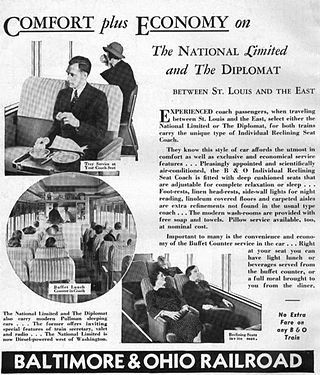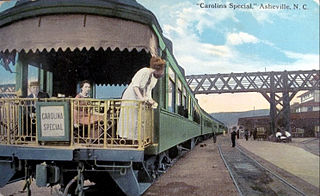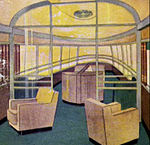
The New York Central Railroad was a railroad primarily operating in the Great Lakes and Mid-Atlantic regions of the United States. The railroad primarily connected greater New York and Boston in the east with Chicago and St. Louis in the Midwest, along with the intermediate cities of Albany, Buffalo, Cleveland, Cincinnati, Detroit, Rochester and Syracuse. The New York Central was headquartered in the New York Central Building, adjacent to its largest station, Grand Central Terminal.

The Lake Shore Limited is an overnight passenger train operated by Amtrak between Chicago and the Northeastern United States, with sections to New York City and Boston. The central segment of the route runs along the southern shore of Lake Erie. East of Chicago, the Lake Shore Limited follows the former main line of the Lake Shore and Michigan Southern Railway to South Bend, Toledo, Cleveland, and Buffalo. From here the train takes the Empire Corridor through Rochester and Syracuse to Albany–Rensselaer station in Rensselaer, New York. At that station, the train divides, with one section continuing to Springfield and Boston in Massachusetts, while the other continues along the Empire Corridor to New York City. The train is scheduled for 19+1⁄2–20+1⁄4 hours for the 959 miles (1,543 km) between Chicago and New York, and 21+1⁄2–22 hours for the 1,018 miles (1,638 km) between Chicago and Boston.

The Cardinal is a long-distance passenger train operated by Amtrak between New York Penn Station and Chicago Union Station via Philadelphia, Washington, D.C., Charlottesville, Charleston, Huntington, Cincinnati, and Indianapolis. Along with the Capitol Limited and Lake Shore Limited, it is one of three trains linking the Northeast and Chicago. The 1,146-mile (1,844 km) trip between New York and Chicago is scheduled for 281⁄4 hours.

The Aerotrain was a streamlined trainset that the General Motors (GM) Electro-Motive Division (EMD) introduced in 1955. GM originally designated the light-weight consist as Train-Y before the company adopted the Aerotrain marketing name.

The Denver Zephyr was a streamlined passenger train operated by the Chicago, Burlington and Quincy Railroad between Chicago, Illinois, and Denver, Colorado. In peak years it ran to Colorado Springs. It operated from 1936 to 1973. The Denver Zephyr continued operating after the Burlington Northern Railroad merger in 1970. BN conveyed the train to Amtrak in 1971; Amtrak merged it with the Denver–Oakland City of San Francisco to form the San Francisco Zephyr and dropped the "Denver" name in 1973.

The Empire State Express was one of the named passenger trains and onetime flagship of the New York Central & Hudson River Railroad. On September 14, 1891, it covered the 436 miles (702 kilometers) between New York City and Buffalo in 7 hours and 6 minutes, averaging 61.4 miles-per-hour (98.8 km/h), with a top speed of 82 mph (132 km/h).

The Cincinnatian was a named passenger train operated by the Baltimore and Ohio Railroad (B&O). The B&O inaugurated service on January 19, 1947, with service between Baltimore, Maryland and Cincinnati, Ohio, carrying the number 75 westbound and 76 eastbound, essentially a truncated route of the National Limited which operated between Jersey City, New Jersey and St. Louis.

The Royal Palm was a named train of the Southern Railway that ran from Cincinnati, Ohio, to Jacksonville, Florida, and then on the Florida East Coast Railway's East Coast Champion to Miami, Florida. The train was discontinued in 1970.

The Xplorer, or Ohio Xplorer, was a named train of the New York Central Railroad (NYC) that traveled between Cleveland and Cincinnati, Ohio. Although the railroad first announced the train in its April 29, 1956, timetable, that timetable did not contain its schedule. The train entered revenue service on June 3, 1956.

The Diplomat was a named passenger train of the Baltimore and Ohio Railroad (B&O) during the 1930s–1950s connecting New York City and St. Louis, Missouri, via Washington, D.C. Other B&O trains on the route during that period were the premier National Limited and the workhorse Metropolitan Special. The train was inaugurated in August 1930 after several changes to trains along the St. Louis Route. After World War II, the Diplomat operated as Train No. 3 westbound, and No. 4 eastbound. It was timed to provide connections to several western railroads that terminated in St. Louis, including the Frisco, the Santa Fe, Cotton Belt and Missouri Pacific, among others.

The James Whitcomb Riley was a passenger train that operated between Chicago, Illinois, and Cincinnati, Ohio, via Indianapolis, Indiana. Originally operated by the New York Central Railroad, it was taken over by Amtrak in 1971. Under Amtrak, it merged with the Chesapeake & Ohio Railway's George Washington to become a Chicago-Washington/Newport News train. In 1977, it was renamed the Cardinal, which remains in operation.

The Lake Shore Limited was a passenger train service operated by the New York Central Railroad between New York City and Chicago, Illinois, from 1897 to 1956. Separate sections linked to Boston and St. Louis. The Lake Shore Limited was the New York Central's first luxury passenger train, and paved the way for its more famous cousin the 20th Century Limited. The 1897 name is now used by Amtrak's Lake Shore Limited, which follows much the same route.

The Nickel Plate Limited, later known as the City of Cleveland and City of Chicago, was a passenger night train operated by the New York, Chicago and St. Louis Railroad between Chicago and Buffalo, New York via Cleveland, Ohio, with through service to Hoboken, New Jersey via Binghamton and Scranton and the Delaware, Lackawanna and Western Railroad for the Buffalo-Hoboken segment.

The Twilight Limited was a named passenger train in the United States which initially operated between Chicago, Illinois, and Detroit, Michigan. The New York Central Railroad introduced the train in 1926, and it continued until the formation of Amtrak in 1971, although it lost its name in 1967. Amtrak renamed the train St. Clair, feeling that the name "Twilight Limited" had undesirable connotations and imagery for a company trying to save passenger rail service. Amtrak revived the name in 1976 for a new train frequency on the Chicago–Detroit corridor, and kept the name until all trains on that corridor were renamed Wolverine in 2004.

The Ohio State Limited was a named passenger train operated by the New York Central Railroad (NYC) between New York City and Cincinnati, Ohio, via Buffalo and Cleveland, Ohio. Service began in 1924 and continued until 1967, with some vestiges remaining until 1971.

The Carolina Special was a passenger train operated by the Southern Railway between Cincinnati, Ohio, and the Carolinas. It operated from 1911 to 1968. It was the last passenger train to use the route of the Charleston and Hamburg Railroad, which, as the South Carolina Canal and Railroad Company, began operation in December 1830, as one of the oldest railroads in the United States, and, by 1833, operated a 136-mile (219 km) line to Hamburg, South Carolina, on the Savannah River, the country's longest at that time. All Southern Railway Pullman service to Charleston rode over that historic, if bucolic, route from Branchville to the port city.

The Green Diamond was a streamlined passenger train operated by the Illinois Central Railroad between Chicago, Illinois and St. Louis, Missouri. It operated from 1936 until 1968. It was the Illinois Central's first streamliner. Initially it operated with Illinois Central 121, the last of the 1930s fixed-consist articulated streamliners built in the United States.

The Maple Leaf was a passenger train pool operated by the Canadian National and the Grand Trunk Western Railroad between Chicago, Illinois and Toronto, Ontario. It operated from 1927 to 1971. The train took its name from the maple leaf, the national symbol of Canada. The Maple Leaf was one of many trains discontinued when Amtrak began operations in 1971, and is unrelated to the Maple Leaf which Amtrak now operates between Toronto and New York City. The train operated on Canadian National railroad territory through Ontario, but west of Lake Huron it operated via Grand Trunk Railroad.
The Canadian and later, Canadian-Niagara, was the longest running named international train from Chicago to Upper Canada via Detroit, for its first two decades running to Montreal. This overnight train was operated by the Michigan Central Railroad from Chicago to Detroit, and in a pool arrangement, it operated over Canadian Pacific Railway tracks and used the same train number from Detroit eastward. The train would carry a second section, bound, variously for Buffalo or New York City via Buffalo.






























